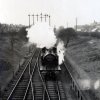These pictures provoked me to get my LTSR books out and have a look. The two main books in question are London, Tilbury and Southend Railway and its locomotives by R. J. Essery published by OPC and Locomotives and Rolling Stock of the London, Tilbury and Southend Railway by R. W. Rush published by the Oakwood Press. Very fascinating books and some beautiful pictures.
The very first picture at Fenchurch Street is of 2153 which is a class 37 originally No. 44 Great Prittlewell built in 1898 by Sharp Stewart and not withdrawn until June 1951. This class was rebuilt with wrap over cabs as per pictures between 1905 and 1911, this one being 1911/1914? Rush has two dates.
The two photos above with the vans are very interesting as the second possibly shows what is known as the Theatrical Van, Diagram 38, 8 built in 1911 originally numbered 6 t0 13. They were 34 feet long with a wheelbase of 21 feet. Originally designed to carry scenery etc. but also used as CCTs. I wonder what is in this one? Is there a theatrical company on its way to London or Southend or is it just for baggage etc.?
The first picture I am not sure, as the LTSR did not have bogie vans like this (?) As for the loco it looks like 2152 which would also make it a class 37 originally No 43 Great Ilford built in 1898 by Sharp Stewart and not withdrawn until April 1951. I think the loco in the second picture could be similar class. There is a lovely picture of No. 43 in original livery in Rush’s book.
Now back to the Baltics - it looks like 2102 (?) So is definitely pre 1929 as it was withdrawn 12/29 and still has MR on the buffer beam. I know you said the pictures were taken between 1914 and 1923. These were designed by the Locomotive superintendent, robbery Whitelegg, as the 87 Class and would have been numbered 87 to 94 making 8. They were approved by the Chairman of the LTS, A. L Stride in 1911 but were not delivered by Beyer, Peacock and Co. until 1912 after the Midland takeover so were painted in Crimson Red livery. The numbering for the engines were 2100 to 2107. It also appears that the loco has a Midland type smokebox door not the original so this makes the date a little later but both Essery and Rush do not give dates. Maybe early 1914 onwards.
Overall they were good engines but due to the controversy over the Midland takeover and the rights of running into Fenchurch Street the trains had and engine change at Barking for the District Electric locos. The Baltics were used on the Ealing Broadway to Southend expresses. Basically there were concerns on the axle loading of these machines. One advantage was that they did not need to be turned and I know of only two other railway companies that used the design. GSWR as Whitelegg went there and the Furness Railway. It is also stated in both books that some of the engines were quickly transferred to the coal trains between Wellingborough and Cricklewood and some working the St Pancras to Luton passenger trains. Interestingly the GSWR had burnished steel boilers again this must have been a fantastic sight.
Bob Esery confirms the model I referred to earlier is a 1” to the foot scale model of number 94 given the name of the “Arthur Lewis Stride” to the original design produced at Plaistow, the LTSR’s works. It is in the intended LTSR llivery and followed the tradition of naming all the locos. They were originally named after the stations on the system but I guess the Baltics would have been named after key personnel.
I have enjoyed looking at this again and thank you for posting these pictures. There is a lot on the LTSR in print and the books mentioned are worth seeking if interested in the line. There are others as well such as the Middleton series. It was and still is a very important passenger line with freight as secondary.



















 , this would be my choice of a city terminus layout in pre- grouping days, along with Goodmans yard.
, this would be my choice of a city terminus layout in pre- grouping days, along with Goodmans yard.






